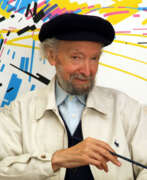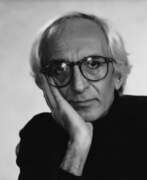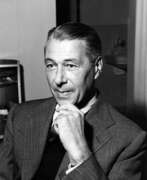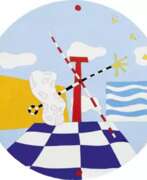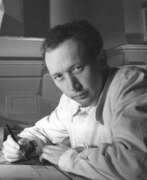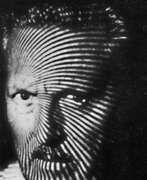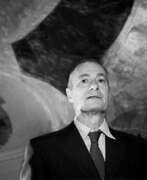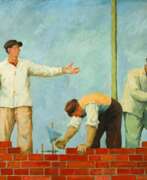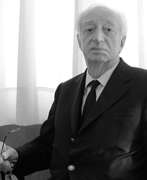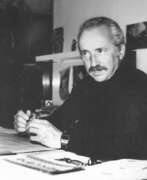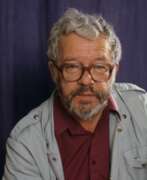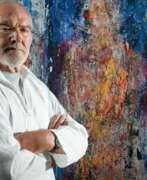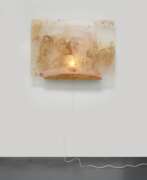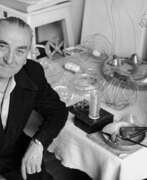Architects Abstract art
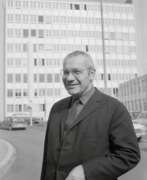

Max Bill, a Swiss artist, architect, painter, typeface designer, industrial designer, and graphic designer, emerged as a key figure in 20th-century art and design. Born in Winterthur, Switzerland, in 1908, Bill's education at the Bauhaus under luminaries like Wassily Kandinsky, Paul Klee, and Oskar Schlemmer profoundly influenced his multidisciplinary approach. His work spans from graphic design, where he was instrumental in shaping Swiss design from the 1950s, to product design with iconic creations like the Ulmer Hocker, a versatile stool designed in 1954.
Bill's contributions to concrete art and his role in founding the Ulm School of Design alongside Inge Aicher-Scholl and Otl Aicher in 1953, mark him as a pioneer who blurred the lines between art, design, and architecture. His theoretical writings and teaching at the Ulm School further underscored his commitment to integrating art with science, shaping a generation of designers and artists.
Noteworthy among his architectural works are his own house and studio built in Zurich-Höngg in the early 1930s and a series of public sculptures that challenge perceptions and engage public spaces in innovative ways. His legacy also includes influential roles in politics, contributions to the field of education, and the establishment of foundations to preserve his work and ideals.
Bill's extensive oeuvre, which also includes timepieces designed for Junghans and a multitude of sculptures, demonstrates his belief in the unity of form and function and the possibility of art to embody the principles of the new physics of the 20th century. His works are not only held in high regard for their aesthetic and functional qualities but also for their ability to convey complex theoretical ideas in tangible forms.
For collectors and experts in art and antiques, Max Bill remains a figure of immense importance, whose works continue to inspire and influence contemporary design and art practices. Sign up for updates related to Max Bill to stay informed about new product sales and auction events showcasing his remarkable contributions to modern art and design.
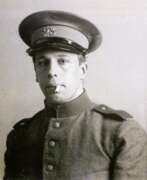

Theo van Doesburg, real name Christian Emil Marie Küpper, is a Dutch painter, architect and sculptor, art theorist, co-founder of the Style Group and of Neoplasticism.
Theo van Doesburg co-founded with Piet Mondrian the De Stijl abstract art movement. The basis of van Doesburg's views was the attempt to reduce all forms of objective harmony in a work of art to certain geometric elements. These new principles soon had a significant influence on the development of architecture, literature, graphics and music.


Lazar Markovich Lissitzky (Russian: Ла́зарь Ма́ркович Лиси́цкий) was a pivotal figure in the avant-garde art movement of the early 20th century, whose contributions spanned across multiple disciplines including painting, architecture, and graphic design. Born in Pochinok, Russian Empire (now in Smolensk Oblast, Russia), Lissitzky is renowned for his profound influence on the development of Constructivism, a movement characterized by the integration of technology and industry into the arts.
Lissitzky's work is distinguished by its innovative use of geometric forms, bold colors, and dynamic compositions, which sought not only to reflect the modern industrial world but also to actively participate in shaping it. His artworks and theories were instrumental in bridging the gap between the avant-garde movements in Russia and Western Europe, facilitating a cross-cultural exchange that enriched the development of modern art. Among his most notable contributions are his "Proun" series, an acronym for "Project for the Affirmation of the New" in Russian, which encapsulates his vision of art as a transformative social force.
His legacy is preserved in some of the world's most prestigious museums and galleries, including the Museum of Modern Art in New York and the Russian State Museum in Saint Petersburg. These institutions house key works that exemplify Lissitzky's groundbreaking approach to art and design, making them a focal point for collectors and experts in the field of art and antiques.
For those deeply invested in the evolution of modern art and its profound impact on culture and society, Lissitzky's work offers invaluable insights into the creative exploration of form and space. His contributions continue to inspire contemporary artists and designers, emphasizing the enduring relevance of his vision.
We invite collectors and art experts to sign up for updates on new product sales and auction events related to Lazar Markovich Lissitzky. This subscription is an opportunity to stay informed about the latest acquisitions and offerings that celebrate the legacy of a visionary artist whose work continues to resonate with audiences worldwide.
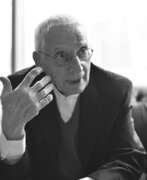

Alessandro Mendini was an Italian designer and architect. He played an important part in the development of Italian, Postmodern, and Radical design. He also worked, aside from his artistic career, for Casabella, Modo and Domus magazines.
The character of his design is marked by what was his strong interest in mixing different cultures and different forms of expression; he created graphics, furniture, interiors, paintings and architecture and also wrote several articles and books. He was renowned as an enthusiastic member of jury in architectural competitions for young designers. He taught at the University of Milan.


Georg Muche was a German painter, graphic artist, designer and architect.
He began his studies in Munich at the School of Painting and Drawing, continuing in Berlin in 1915. Already influenced by Wassily Kandinsky and Max Ernst, he became one of the first proponents of abstract art in Germany. In Berlin, Georg Muche began collaborating with the expressionist painter Gerwart Walden (1879-1941) and his artist group Sturm.
In 1919 Walter Gropius appointed Muche to the Bauhaus in Weimar, where he became its youngest master. He also ran a weaving workshop in Dessau. In 1926, the Metal Prototype House on the Dessau-Törten estate was built to a design developed in collaboration with the architecture student Richard Paulik. From 1939 to 1958 Georg Muche worked in Krefeld, teaching a master class in textile design at the engineering school.
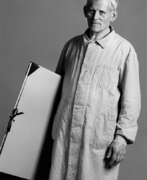

Heinrich Neuy is a German artist, furniture designer and architect. His design orientation was shaped by classical modernism. After training as a carpenter, he studied at the Bauhaus in Dessau under Josef Albers, Wassily Kandinsky and the architect Ludwig Mies van der Rohe.
Later, Heinrich Neu developed his own style, characterised by bold colour and abstract composition and dynamic form.
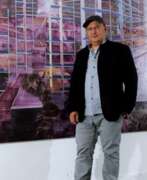

Driss Ouadahi is an architect and artist originally from Morocco who lives and works in Germany.
He studied at the Hochschule für Beaux-Arts in Algiers and at the Düsseldorf Academy of Art. The abstract architectural forms in Ouadahi's work are surprisingly a response to the buildings of real Algerian houses.
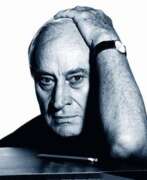

Giò Pomodoro was an Italian sculptor, printmaker, and stage designer. His brother is the sculptor Arnaldo Pomodoro.
In 1954 he moved to Milan, where he associated with leading avant-garde artists and started making jewelry. He then began to produce reverse reliefs in clay and also formed assemblages of various materials, including wood, textiles, and plaster subsequently cast in metal.
During the 1960s, he developed several series of sculptures, which explored a range of abstract shapes, usually with smooth undulating surfaces. In his later career, Pomodoro regularly received public commissions and produced a number of large outdoor structures.
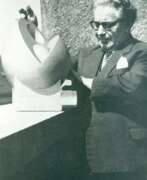

Victor Servranckx was a Belgian artist renowned for his pioneering contributions to abstract painting and design. Born in Diegem in 1897, Servranckx's artistic journey commenced at the Brussels Royal Academy of Fine Arts, where his studies spanned from 1913 to 1917. It was here he forged a significant connection with René Magritte, leading to their collaborative work "Pure Art: A Defence of the Aesthetic" in 1922.
Victor Servranckx's art is distinguished by its embrace of cubism, constructivism, and surrealism, showcasing a dynamic interplay of geometric forms and innovative design principles. His artistic endeavors were not confined to painting alone; he delved into abstract sculpture and collage, contributing significantly to various art magazines and influencing future generations of artists.
Noteworthy is Victor Servranckx's international recognition, evidenced by his participation in exhibitions across Europe and the United States. His works were exhibited alongside notable figures like Marcel Duchamp and Fernand Léger, highlighting his importance in the art world. Despite a mixed reception in Belgium, his influence endured, culminating in a retrospective at the Musée d'Ixelles shortly before his death in 1965.
For collectors and experts in art and antiques, Servranckx's oeuvre represents a vital chapter in the history of abstract art, offering a window into the evolving artistic trends of the early 20th century. His works, such as "Opus 17-1922" and "Opus 30-1922 (Factory)," are emblematic of his innovative approach and are held in high regard in collections worldwide, including the Museo Nacional Thyssen-Bornemisza.
If Victor Servranckx's artistic vision resonates with you, consider staying updated on exhibitions and auction events featuring his works. Subscribing to updates will ensure you're informed about new opportunities to explore and acquire pieces by this influential artist.
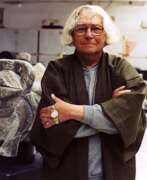

Pierre Szekely was a Hungarian sculptor, architect and educator. In the 1940s, after surviving the holocaust, Szekely became a resident of France, and eventually became an avante garde architect and international lecturer of art philosophy.
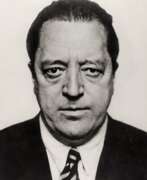

Ludwig Mies van der Rohe, born Maria Ludwig Michael Mies was a German-American architect and furniture designer. He was commonly referred to as Mies, his surname. Along with Alvar Aalto, Le Corbusier, Walter Gropius and Frank Lloyd Wright, he is regarded as one of the pioneers of modernist architecture.
In the 1930s, Mies was the last director of the Bauhaus, a ground-breaking school of modernist art, design and architecture. After Nazism's rise to power, with its strong opposition to modernism (leading to the closing of the Bauhaus itself), Mies emigrated to the United States. He accepted the position to head the architecture school at what is today the Illinois Institute of Technology in Chicago.
